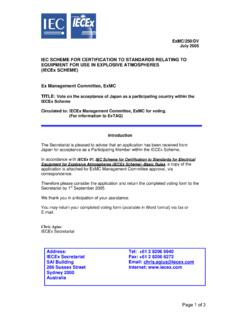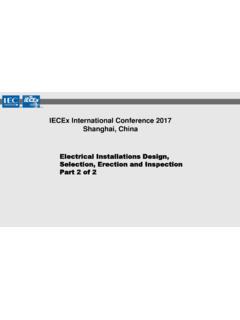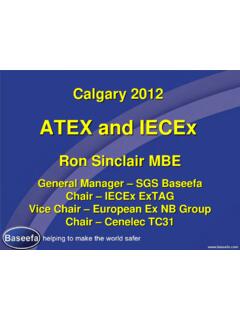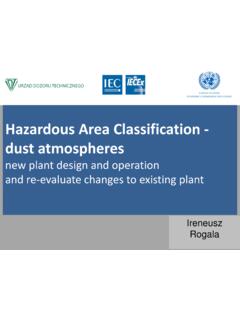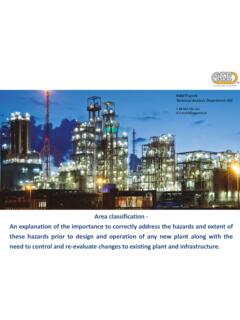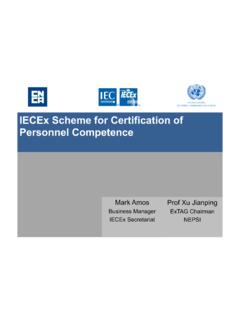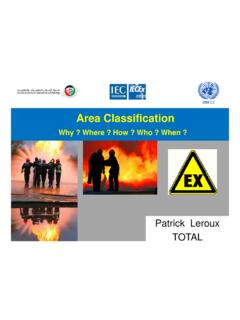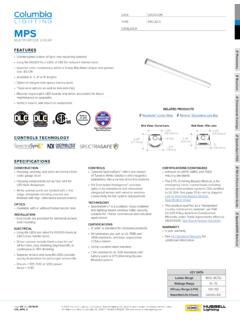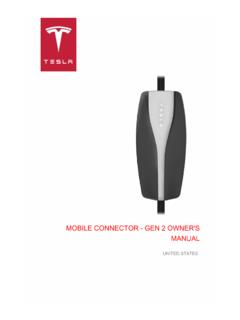Transcription of Overview of Explosion Protection Techniques - IECEx
1 Overview of Explosion Protection Techniques IECEx2018 International ConferenceJakarta, Indonesia8thand 9thAugust 2018 Karel Neleman Technical ManagerINTRODUCINGWhy am I Promotion of to be the one and only accepted certification system!To achieve total ACCEPTANCE there s a first need for CONFIDENCE. Each stakeholder needs to understand ISO/IEC based Types of s start a quick guide:Ignition sources1. Hot surfaces2. Flames, hot gases, hot particles3. Mechanically generated sparks4. Electrical equipment5. Stray electric currents, cathodic corrosion protection6. Static Electricity7. Lightning8. radio frequency (RF) electromagnetic waves 300 GHz9. Electromagnetic waves > 300 GHz10. Ionizing Radiation 11. Ultrasonics12. Adiabatic compression and shockwaves13. Exothermic reactions, including self-ignition of dustsIgnition sourcesis commonly known as to deal with just Electrical aware that we have today working close together. Non-electrical equipment shall be assessed in hazardous areas as basic knowledge is anyhow groupRepresentativegasIICH ydrogen, Acetylene, CarbonDisulphideIIBE thene, DimethyletherIIAP ropane, Petrol, Ethanole, Acetone, Acetaldehyde Gas GroupsGases are divided in sub groups because Ignition Current / Energy Experimental Safety GapRemark:1stline (IIC) are most dangerous GroupsDusts are divided in sub groups because of types of dust:Remark: 1stline (IIIC) are most dangerous dusts (for IP rated electrical equipment)where IIIB is dangerous when there is possible electrostatic charge Dust groupTypes ofdustRepresentativedustIIICC onductivedustsGraphitePowder, To n e rIIIBNon-conductivedustsMilkPowder, PowderedSugarIIIAF ibers andFlyersTobacco,SawDustTemperature classes on equipmentare applicable to gases and indicate the max.
2 Acceptable surfacetemperatureHow to read and use this table?When a site is classified as Zone 1 / IIA / T4 Hot surfaces become dangerous 135 that reason allEx equipment shall be selected having a T class T4, T5 or T6. Remarks:The higher the T class, the lower the belonging acceptable temperature.(T6 classified sites are most dangerous, T6 certified equipment is most safe!)T classSurfaceTemperatureT1450 CT2300 CT3200 CT4135 CT5100 CT685 CAmbient temperature rangeEx manufacturers and IECEx ExCB s apply -20 C to + 40 C as a no indication on the Ex type label this default an extended range is required because of the application;it shall be indicated and must be Indonesia around the Equator you actually might have earlier troubles with the humidity instead of the ambient Protection LevelThis is to identify in which Zone an equipment can be used:EPLA pplicableZone Safety level descriptionGa0 Abnormaloperationwith2 mal-functionsGb1 Normaloperationwith1 mal-functionGc2 NormaloperationEPLA pplicableZone Safety level descriptionDa20 Abnormaloperationwith2 mal-functionsDb21 Normaloperationwith1 mal-functionDc22 NormaloperationEPLA pplicableZone Safety level descriptionMaUnderground MiningExplosionrisk?
3 OperationsafelypossibleMbUnderground MiningExplosionrisk? DisconnectionrequiredCapitals?When identifying markings on equipment be aware!Level of protectionSafety levelaVeryhighbHighcNormalGroupingSuitab leforGases(II)SuitableforDusts (III)CMost easy ignitableConductiveBEasyignitableNon-con ductiveAIgnitableIgnitableFibers & FlyingsTypes of Protection (electrical)Most common applied types according to the IEC 60079 standards, parts:PartCodeDescription1dFlameproofequ ipment2pPressurization5qQuartzencapsulat ion7eIncreasedsafety11iIntrinsicsafety15 nNon incendive18mMouldedencapsulation28opOpti cal radiation31tProtectionbyenclosureFlame proof enclosure Ex dBasic design is: enclosure is strong enough to withstand internal explosionThis design allows internal ignition sources, like sparks and (limited) hot path based on of built-in devices (next speaker will explain)Increased safety Ex eBasic design is: increased safety level for normally non sparking apparatus This design does notallow any (unprotected) sparking components insideCritical (IP rating, impact strength etc.)
4 (wiring and terminations)Intrinsic Safety Ex iBasic design is: limitation of energy in the whole electrical circuit Energy [ J] = x C x U = Capacity [ F]x Voltage [V] Energy [ J] = x L x I = Inductivity [mH] x Current [mA] Intrinsic safe circuits are normally supplied from safe area and basically limiting the Voltage by Zener diodes and the Current by a into account maximum cable length because of increasing C and L. Typical designHazardous AreaSafe AreaThe bluecircuit shallbeing verified before commissioning (see IEC 60079-14)Moulded encapsulation Ex mBasic design is: moulding of the electrical circuitExamples of application: - Solenoid ValvesEx mbIIC T5 Gb- Printed Circuit BoardsSolenoidCritical aspects (for Manufacturer) of the free volumes are of the potting shall be non-hygroscopicEx ebmbSerial interfaceNon Incendive Ex n (for EPL Gc only)Basic concept: Ex n consists of several sub types of Protection . In most cases being simplified versions of existing types of Protection :IEC 60079-15Ex nAnon Arcing becomes Ex ecIEC 60079-7Ex nC enclosed Construction becomes Ex dc IEC 60079-1(or hermetically sealed)or Ex mc IEC 60079-18Ex nR Restricted breathingEx nRRestricted BreathingLight fixtureTest tool Remark: Not easy to guarantee nR during Life CycleOptical radiation Ex opBasic design is: safety by either limitation of radiation or Protection of optical light.
5 This type of Protection is divided in:Ex op is inherent safe (limited optical energy in mW/mm )Ex op pr protected (light source/channel is physical protected) Ex op sh with interlock(fibre optic loop monitoring; no return = stop)Ex db op isEx db op prsensorconnectorPressurized enclosures Ex pBasic design is: keep dangerous atmosphere outside by overpressureAspects:1. First a purging of 5 times the internal volume2. For EPL Gb redundant guarding of the flow required 3. Then compensation of leak losses + power on4. For EPL Gb mandatory power off when pressure dropsSpark arrestorin the outlet !Powder (quartz) filling Ex qBasic design is: extinguish any ignition source in a quartz filled enclosure Example: Mobile ComputerElectronics in quartzKeyboard and Touch screen intrinsic safe with intrinsic safety [ib ] certificate = specific conditions of use!! Protection by enclosure Ex t (for dust only)Basic design is: minimum IP degree for dust tight enclosure Depending on the dust group a minimum IP rating of either IP5X or IP6 XRemark:X = don t care (for dust) because 2nddigit is for ingress Protection against waterCritical or 6X rating depending on EPL and Dust dissipation to fulfil the max.
6 Surface temperature indicated as C Marking of equipment Based on applied type(s) of Protection including their level of protectionThese levels of Protection are: for Product .. from Manufacturer ..LevelSafety level descriptionaVeryhighbHighcNormalRemark:1 product, 10 certificates!notcoveringworldwidesalesMa nufacturers and users prefer one single system!In previous Conferences we did already do some want the IECExSystem!!Malaysia 2014 Poland 2015 China 2017We want the IECExSystem!!Today here in Jakarta shortly againLet s do a want the IECExSystem!! Overview of types of protectionIEC 60079-14 differentiates these types for each Equipment Protection LevelLevelEx dEx eEx iEx mEx nEx opEx qEx pGaEx da-Ex iaEx ma-Ex op is--GbEx dbEx ebEx ibEx mb-Ex op is/pr/shEx qbEx pxb/pybGcEx dcEx ecEx icEx mcEx nA/nC/nREx op is/pr/sh-Ex pzcLevelEx iEx mEx opEx pEx tDaEx iaEx maEx op is-Ex taDbEx ibEx mbEx op is/pr/shEx pbEx tbDcEx icEx mcEx op is/pr/shEx pcEx tcRemark:Don tmix up Db & db!!How to read the markings?
7 Let s demonstrate a sample:Ex : Explosion : Flameproof d with level of Protection b .eb : Increased safe e with level of Protection b .[ia Gb] : Square brackets [ ] = associated apparatus, intrinsic safety with level of Protection a ,overall application is because of the insert max. for Equipment Protection Level +H2: Group IIB additional including Hydrogen. T5 : Max. surface temperature classified T5 (100 C).Gb : This whole assembly has EPL Gb (zone 1).DEK : Responsible Certification Body : Year (2013) of initial issue : Certificate (serial) number from to read the online Certificate of Conformity?Preferable you select equipment to current editionsNon-electrical equipmentToday, there are two parts in ISO/IEC 80079 series of standards available:Marking includes Ex h with info in CoC:* Types of Protection c, b en k will notbeing marked on the product, because of possible user mis-interpretation with levels of Protection c and b .Manufacturers shall indicate Ex h only and have to define the specific used method(s) in the user installation requirements; Hazard assessment37c*ConstructionalSafetyb*Cont rol of IgnitionSourcesk*Liquid immersionLast but not least:When a Certificate of Conformity has a numbering like SIR That X is for CoC salwaysindicating a Specific Condition of Use !
8 So; it is neithera placeholder for any future numbering nora don t care !!!X? Let the alarm bells ring!Thank youKarel Neleman Technical Manager
